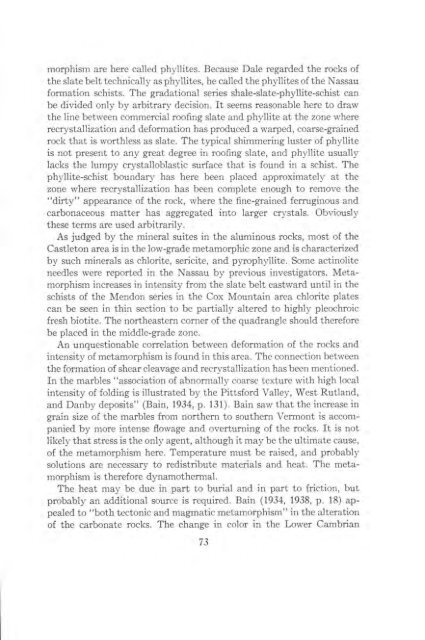STRATIGRAPHY AND STRUCTURE CASTLETON AREA VERMONT
STRATIGRAPHY AND STRUCTURE CASTLETON AREA VERMONT
STRATIGRAPHY AND STRUCTURE CASTLETON AREA VERMONT
Create successful ePaper yourself
Turn your PDF publications into a flip-book with our unique Google optimized e-Paper software.
morphism are here called phyllites. Because Dale regarded the rocks of<br />
the slate belt technically as phyllites, he called the phyllites of the Nassau<br />
formation schists. The gradational series shale-slate-phyllite-schist can<br />
be divided only by arbitrary decision. It seems reasonable here to draw<br />
the line between commercial roofing slate and phyllite at the zone where<br />
recrystallization and deformation has produced a warped, coarse-grained<br />
rock that is worthless as slate. The typical shimmering luster of phyllite<br />
is not present to any great degree in roofing slate, and phyllite usually<br />
lacks the lumpy crystalloblastic surface that is found in a schist. The<br />
phyllite-schist boundary has here been placed approximately at the<br />
zone where recrystallization has been complete enough to remove the<br />
"dirty" appearance of the rock, where the fine-grained ferruginous and<br />
carbonaceous matter has aggregated into larger crystals. Obviously<br />
these terms are used arbitrarily.<br />
As judged by the mineral suites in the aluminous rocks, most of the<br />
Castleton area is in the low-grade metamorphic zone and is characterized<br />
by such minerals as chlorite, sericite, and pyrophyllite. Some actinolite<br />
needles were reported in the Nassau by previous investigators. Metamorphism<br />
increases in intensity from the slate belt eastward until in the<br />
schists of the Mendon series in the Cox Mountain area chlorite plates<br />
can be seen in thin section to be partially altered to highly pleochroic<br />
fresh biotite. The northeastern corner of the quadrangle should therefore<br />
be placed in the middle-grade zone.<br />
An unquestionable correlation between deformation of the rocks and<br />
intensity of metamorphism is found in this area. The connection between<br />
the formation of shear cleavage and recrystallization has been mentioned.<br />
In the marbles "association of abnormally coarse texture with high local<br />
intensity of folding is illustrated by the Pittsford Valley, West Rutland,<br />
and Danby deposits" (Bain, 1934, p. 131). Bain saw that the increase in<br />
grain size of the marbles from northern to southern Vermont is accompanied<br />
by more intense fiowage and overturning of the rocks. It is not<br />
likely that stress is the only agent, although it may be the ultimate cause,<br />
of the metamorphism here. Temperature must be raised, and probably<br />
solutions are necessary to redistribute materials and heat. The metamorphism<br />
is therefore dynamothermal.<br />
The heat may be due in part to burial and in part to friction, but<br />
probably an additional source is required. Bain (1934, 1938, p. 18) appealed<br />
to "both tectonic and magmatic metamorphism" in the alteration<br />
of the carbonate rocks. The change in color in the Lower Cambrian<br />
73













